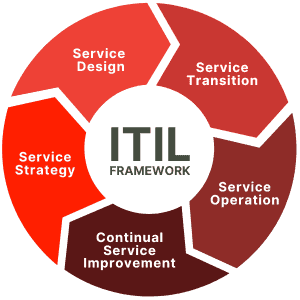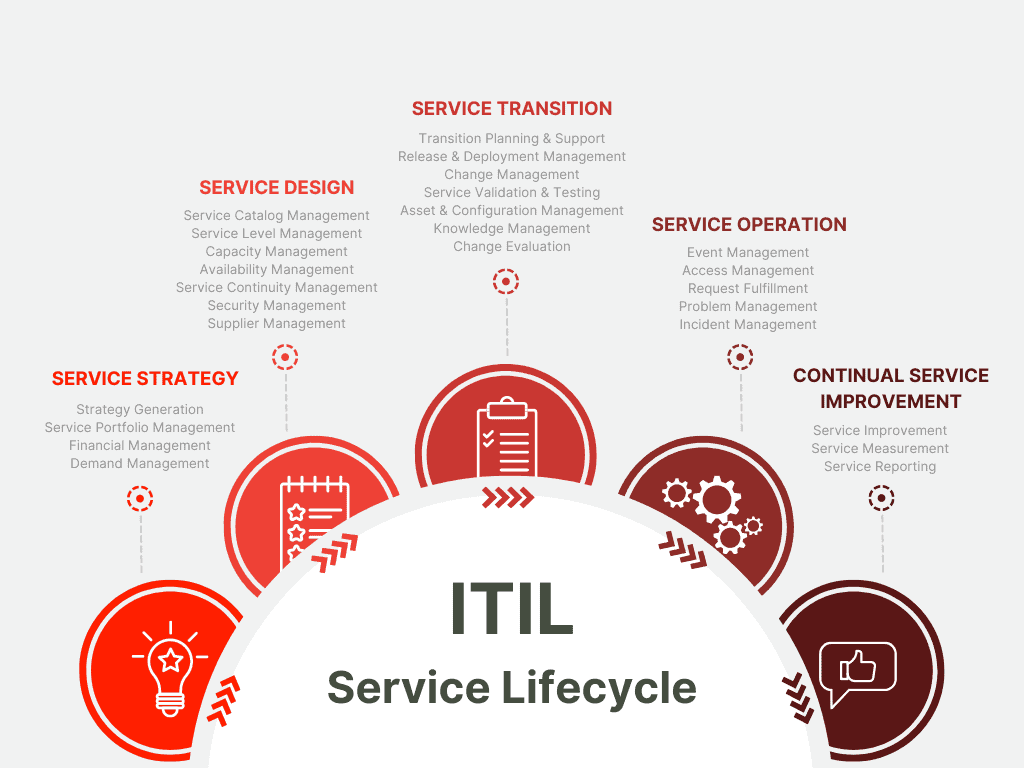Are you frustrated with the complexities of IT and information technology management? An easy-to-understand framework known as ITIL provides a comprehensive service management approach to maximize the delivery of IT services. In this blog post, our Chief Information Officer, Jonas Fernandes, shares his insights on ITIL, along with the direct benefits it provides, and why CMIT adopted ITIL practices as a leading provider of IT managed services.
Q: WHAT IS AN IT INFRASTRUCTURE LIBRARY (ITIL)?
JF: ITIL (Information Technology Infrastructure Library) is an Information Technology Service Management Framework comprised of best practices that helps align IT services with business needs. ITIL uses a systematic approach that helps organizations manage risk, improve customer relations, increase efficiency, and build a stable, scalable IT environment. There are five stages of the ITIL Service lifecycle and is comprised of 26 processes.
Q: WHAT IS THE ITIL SERVICE FRAMEWORK?
JF: There are five different stages of the ITIL lifecycle model, each with a specific aim and goal:
Service Strategy
Service Strategy helps organizations determine which services the IT organization is to offer and what capabilities need to be developed. The goal of Service Strategy is to decide on a strategy to serve customers.
Service Design
Service Design coordination ensures the consistent and effective design of new or changed IT services, service management information systems, architectures, technology, processes, information, and metrics. The goal of Service Design is to coordinate all service design activities, processes, and resources.
Service Transition
The Service Transition lifecycle stage also makes sure that changes to services and service management processes are carried out in a coordinated way. The goal of ITIL Service Transition is to build and deploy IT services.
Service Operation
The Service Operation lifecycle stage includes the fulfilling of user requests, resolving service failures, fixing problems, as well as carrying out routine operational tasks. The goal of ITIL Service Operation is to make sure that IT services are delivered effectively and efficiently.
Continual Service Improvement
The Continual Service Improvement (CSI) process uses methods from quality management to learn from past successes and failures. The goal for ITIL CSI lifecycle stage aims to continually improve the effectiveness and efficiency of IT processes and services, in line with the concept of continual improvements.
Q: WHAT ARE THE ADVANTAGES OF USING ITIL?
JF: Some advantages of using ITIL include:
- Provides the most optimal way to convert demand into desired outcome
- Financial management
- Better customer satisfaction
- Better decision-making processes
- Improved service availability
- Better control over infrastructure services
- Builds a clear structure of an organization
Q: HOW DOES CMIT UTILIZE ITIL IN THEIR BUSINESS?
JF: CMIT has adopted ITIL practices in several areas of service management. To highlight a few key areas, CMIT uses an ITIL Service Strategy in change management, incident management, problem management, and project management.

CMIT’s Change Management process allows the organization to move from the current state to a future desirable state using a coordinated and structured approach in collaboration with stakeholders. This approach minimizes the disruption of products and services while maximizing successful results for implementations.
Incident Management (Service Operation)
CMIT’s Incident Management process ensures that appropriate methods and strategies are implemented for effective response, broad analysis, documentation, reporting incidents, and other ongoing management services. It also reports progress stats and connectivity options of incident management to support staff. It sets priorities and activities efficiently as well as manages and controls user-experience with improved IT services. Incident Management provides the framework to ensure user issues are solved as quickly as possible.
Problem Management (Service Operation)
CMIT’s Problem Management processes are mainly responsible for recognizing and troubleshooting recurring incidents, determining the root cause of these occurrences, and making sure CMIT takes appropriate action to prevent these incidents from reoccurring. CMIT’s Problem Management practice operates alongside other implemented ITIL practices, namely Incident Management and Change Management.
Q: WHAT SHOULD OUR CUSTOMERS KNOW ABOUT ITIL?
JF: Customer satisfaction is the number one metric of success. CMIT’s use of the ITIL methodology helps us deliver a consistent quality of services, resulting in increased customer satisfaction, better service deliveries, and better control over risks and service disruption. CMIT’s established baselines, upon which improvement efforts are measured, demonstrate success, and identify areas for continuous service improvement. As a leading provider of IT managed services in the industry, we are constantly striving to improve our services.
ROOM FOR IMPROVEMENT
In today’s world, organizations are constantly looking for solutions to improve their operations and maximize their overall efficiency. ITIL is one of those solutions that can help organizations achieve a more streamlined workflow. By adhering to the principles of ITIL, organizations have the ability to better manage finances, increase customer satisfaction, and make more informed decisions – all components that attribute to business success. Reach out to us here at CMIT Boston Cambridge. We’re always here to help.
Written by: Jonas Fernandes | @CMITBostonCambridge







